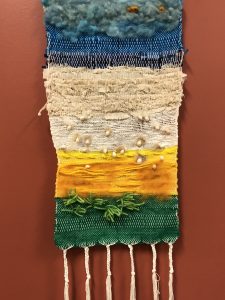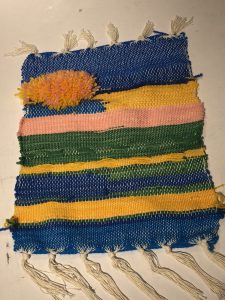Chloe Kim Weaving

Final Weaving
Intention:
My beginning inspiration was from the landscape sample weavings of my classmates. However, I decided to sketch out different kinds of the landscape from what I had seen before because I wanted to try something new. So I sketched out a landscape that makes sense both when it’s viewed from the top and also when it’s seen from the eye level of weaving while it’s flat on the surface. I find an object astounding when it’s pleasing on various perspective. For this weaving, I wanted the viewer’s experience to be different when viewing from the top while it’s hanging on the wall, and when seeing flat on the surface. To fulfill my intention, I had to experiment with diverse texture using the yarn and also to add different materials to support the dynamic purpose of the weaving.
Process:
The primary materials I used was yarn and felt. But I also used seashells to illustrate realistically of ocean scenery. I used different kinds of technique depending on the intention of each section of my weaving. The entire piece was divided into four sections thus in the grass field; I used Ghiordes knots to contextualize three-dimensional grass. And on the golden field, I mixed up felts and various kinds of weaving to show textured field. And for the white sand field, I used seashells and felts to indicate their shadows and fix them on to the weaving. For the ocean, I used a rubber band on the transition section from think paper sand to the sea. Introducing rubber band was successful because the rubber band revealed lots of warp yarns helping transition between two very different materials and contrasting colors. Also, I used more than three colors to felt ocean to realistically indicate the waves.
Learning:
From this project, the most shocking learning experience was how differently people react to a single object. Since each audience has varying backgrounds and perspectives, they read my weaving very differently. However, this was exciting as a maker because whether they interpret similar to my intention or not it’s interesting to hear what people got out of a piece I created. While weaving for the final project, I learned how to mix different materials and still have a smooth transition and a cohesive piece. I believe that my final weaving piece had a stronger cohesion than the sample piece because I tried hard to keep cohesion while introducing many different textures and materials. Since I’m satisfied with the piece, I don’t see a lot of things to do differently, but I want to try introducing more materials like seashells because it was fun to find a balance between harsh surfaced and soft materials.

Sample Weaving